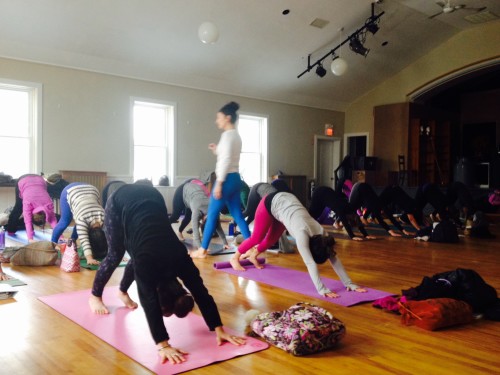
Sometimes when teaching it makes sense to stop the class. This is one of those things that as teachers, we should use with caution; you don’t want be stopping class all the time because it breaks the flow. Part of the challenge of teaching is to fit in the key instruction while keeping the class moving. But there are indeed some times that it might make sense. Consider:
You want to show something before asking them to do it;
You want to show something you’re seeing in class that is incorrect;Â
You want to show the correct way to do something.
There might be a few other reasons but let’s start with these.
In the first case, you might want to demonstrate a pose. This could be something you’re ready to offer up right in the moment or something you’ll build to in the class. It makes the most sense to demonstrate the pose right before you ask them to do it. Be sure you’re in a spot in class where everyone can see you or ask them to move. Even better, consider asking a student you know if they are willing to do the pose and use them as a model so you can talk to the posture as someone else is in it ( be sure you check with the person before you dive in and ask them if they are comfortable doing the pose).
In the second case, you might want to show something you’re seeing a great deal of in class so you can point out what’s incorrect. I use this a great deal when it comes to moving from high to low push up. There is much to this movement so my focus might be on the overall movement or one aspect of it (for instance, how low you should go). In any event, be careful when you demonstrate this. One of the biggest areas of teacher injuries is the instance when you show something the “wrong way.” Be sure to move slowly as you show this movement or pose, whatever it is. Speak clearly. Stay away from being angry or expressing displeasure; state your point and then ask them to try it.
In the last case, you might want to show the correct way to do something. Obviously, this scenario goes well with the one above. I use this a great deal when speaking to the feet in Wheel pose. I show the feet turning out (while I’m standing and moving into a standing backbend). I then turn my feet straight ( i.e. “the correct alignment”) and move into the standing backbend.
Many students need to see something first before the concept sticks. Many students are visual learners versus auditory. Also, many students aren’t listening to you when they practice because they’re listening to their own thoughts  (yup, it happens!). Another case is that they are set in their ways and resistant to new or different instruction. Remember: Be a teacher but don’t be a pain in the you-know-what. If you don’t see what you want after stopping and demonstrating and then giving more cues in the moment, move on. This is especially hard for teachers like myself that focus on the anatomy of yoga. Your intentions are good but remember, everyone is coming to the mat from a different perspective, with different experiences and different awareness of their body. Your job is not to “fix” them but to support them through the process.
Most of all, don’t be afraid to BE the teacher. This means that if your instinct says to stop the class, do it. Don’t hesitate, Don’t be afraid. If you’re unsure, it will come across that way. Own what you know but be sure you do indeed know why you’re doing what you’re doing. I always like to say to new teachers, “If you offer anything up, have a reason for doing so, versus, “this is what I was told.” If you tell people to keep their feet straight in backbends, know why. If you ask them to lower less than halfway down when moving to low push up, know why. Remember, there are many different approaches to yoga (yes, it’s true!) so you may indeed be offering something up that students may not have heard before (people ask me all the time why I don’t suggest a block under the hip in Pigeon anymore). Just know your “why,” have some background to back it up, stay open (read: less defensive) and carry on.
Teach, be you and support your students.
